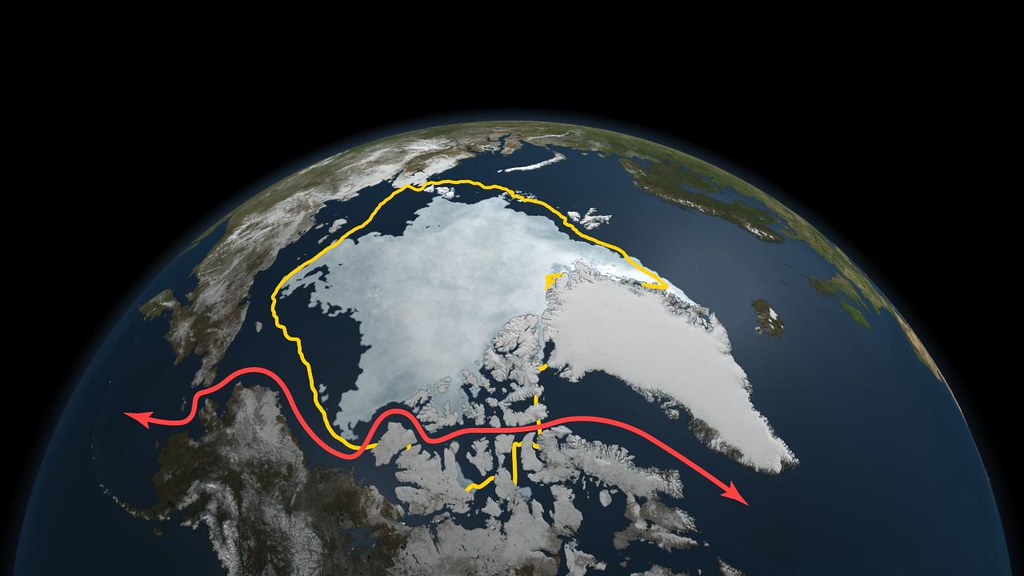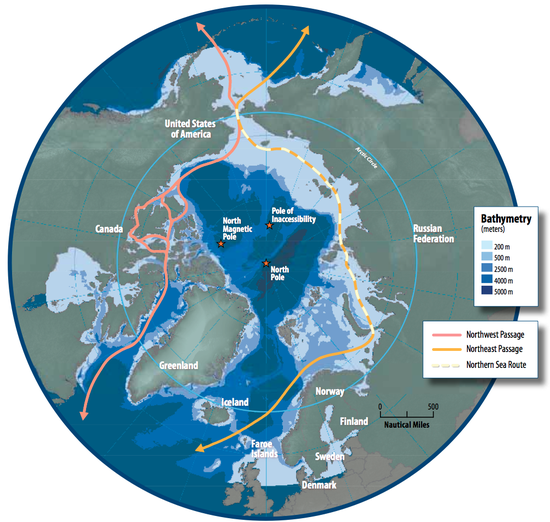
The Challenges of an Ice-Free Arctic
Even though less than 4 million people live above the Arctic Circle, the world is connected in the high north in ways we’re only beginning to see. Climate change is melting sea ice at an unprecedented rate, and soon there will be no permanent sea ice in the Arctic. This change will have profound economic, political, and security impacts inside and outside of the Arctic.
Economic:
Manmade shortcuts around the world, like the Suez and Panama Canals, have cut the costs and distances of shipping routes dramatically. Those routes are still wildly inefficient compared to what’s possible by navigating the Arctic Sea.
For example, the sea route from East Asia to Western Europe currently navigates through the Suez Canal, covering a total distance of roughly 21,000 km. By traveling through the Bering Strait and across the Arctic Sea, the sea route to Western Europe is approximately 12,800 km. The new and shorter way takes just ten days, compared to the traditional 15-day journey. The new route may become even shorter once infrastructure along Russia’s northern coast is built.
China has been a critical player in developing the infrastructure and technical know-how to navigate these new routes effectively. The buildup along Russia’s northern coastline is, in part, funded by Chinese investments. Additionally, in 2016, China’s Maritime Safety Administration released an elaborate guide on how to successfully navigate the Northwest Passage, which travels through the Canadian Archipelago to the Atlantic.
Shipping through the Arctic is also making Chinese goods even more competitive. Chinese ships have already begun using the Northern Sea Route, which follows Russia’s northern coast to reach Europe. The shorter route requires less fuel than the traditional routes do, and the deep Arctic Sea allows ships to carry more cargo than those traveling through the shallow Suez Canal. Faster routes carrying more cargo and using less fuel could transform how Chinese goods compete in western markets.

Source: Wikimedia Commons
Political:
Eight nations claim territory in the Arctic Circle: Denmark (Greenland), Iceland, Russia, Canada, the U.S., Norway, Finland, and Sweden. Together, these nations form the Arctic Council, which was created to promote cooperation between the Arctic states. However, the council has significant rifts that keep it from effectively coordinating and cooperating.
Notably, Russia is at odds with NATO-aligned countries on the Arctic Council. As Russia’s northern coast has begun to thaw, it has made an effort to develop military infrastructure along its northern coast. Russia controls roughly half of the territory along the Arctic coastline. It continues to create islands that would push its territorial claims deep into what would otherwise be international waters. These developments worry NATO leaders, who are concerned that territorial or resource disputes with Russia in the fragile Arctic could quickly escalate into a military confrontation.
Recently, the U.S. has been resistant to the council’s work on combatting climate change and developing a security framework for the Arctic. At the 2019 meeting of the Arctic Council, the U.S. was the only nation unwilling to sign a joint declaration setting the agenda for the council’s climate and security dispute work over the next two years. The U.S.’ refusal to cooperate has left the council without an agreed-upon agenda, setting the effort to reach cooperative agreements on security and climate issues back years.
Canada’s longstanding, and until recently unchallenged, position on the Northwest Passage has been that the waters of the Canadian Archipelago are sovereign. The international community, however, argues that the Northwest Passage is an international waterway. As an international waterway, the Northwest Passage would be open to tax-free shipping, preventing Canada from collecting revenue from passing ships.
In the 1980s, the U.S. challenged Canada’s claim of sovereignty when it sent a U.S. Coast Guard ship through the passage unannounced. The incident elicited backlash from the Canadian government and strained the U.S.-Canada relationship. The issue remains unresolved and will continue to be a point of contention among Canada, the Arctic states, and other global economic powers.
Security:
Melting Arctic sea ice has spawned significant direct and indirect security issues.
Direct
Russia’s military buildup along its northern coastline threatens to turn disputes over territory and natural resources into an armed conflict. The use of shipping lanes that travel north to the Arctic through disputed waters may inflame territorial disputes between China and its neighbors.
Policing the U.S.’s territorial waters in the north will require significant new assets. The Coast Guard has requested nearly a billion dollars for new polar ice breakers, and the Department of Defense has emphasized the need for an Arctic strategy. In response, Congress added provisions on Arctic defense to the 2020 National Defense Authorization Act (NDAA). One of the provisions requires the Defense Department to report to Congress on potential sites for one or more strategic ports in the Arctic. Another provision requires reporting on Russian and Chinese activities in the Arctic.
Indirect
Melting sea ice will cause sea levels to rise worldwide. Seas are rising an average of 3.2 mm per year. By 2100, sea levels could be 2 m higher. That would put significant portions of the world’s population at increased risk of severe flooding, including millions living in New York, Hong Kong, Mumbai, and other major coastal cities. Rising seas will also pose an existential threat to island communities, like Tuvalu and Hawaii.
The changing composition of Arctic water also poses ecological and geophysical threats. Arctic sea ice acts as a mirror for solar energy. The loss of that mirror, coupled with the release of stored methane from within the ice, will contribute adversely to climate change. Additionally, melting Arctic sea ice will strain fisheries in the Arctic, which provide sustenance and income for millions of people.
Conclusion:
Scientists predict summers in the Arctic to be ice-free by 2050. An ice-free Arctic creates challenges, but it also poses opportunities. The U.S. and the world must work diligently to ensure that this new frontier will be an opportunity for cooperation rather than a front for great power competition.





